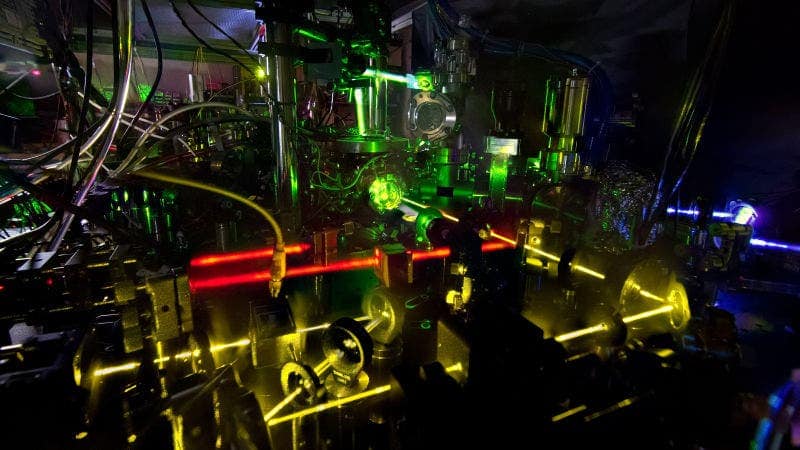Scientists have made optical atomic clocks that ‘tick’ a quadrillion times a second, making them accurate enough to potentially measure the gravitational distortion of space-time across the Earth’s surface more precisely than current methods. In the future, this sort of atomic ticker could be used to detect gravitational waves, test general relativity, and even search for dark matter.

The flow of time is not absolute — it is relative, as we’ve come to know thanks to Einstein’s work. When you’re having fun, times flies in a breeze and, conversely, when we’re faced with a daunting task, it seems to take forever. But this is merely our subjectivity playing tricks on us. What’s more remarkable is that even seemingly objective measures of time, such as the swing of a finely-tuned pendulum, can be relative. For instance, a clock placed on Mt. Everest will tick slightly faster than the same clock at sea level due to the effects of the gravity potential.
In order to compare and sync clocks at different points in a gravity field, we’re forced to establish a common reference surface. For planet Earth, this is the geoid — the surface of equal gravitational potential representing the global-mean sea level. Today, the geoid is determined by altimetry measurements performed by satellites and physical models of the planet’s gravity. Both approaches have limitations that introduce uncertainties of several centimeters. With atomic clocks, these imprecisions could become minimal.
Physicists at the National Institute of Standards and Technology (NIST) recently demonstrated one such device — an optical atomic clock that traps a thousand ytterbium atoms in optical lattices (grids made of laser beams). An analog clock measures a second as the complete oscillation of a pendulum, for instance. An atomic clock is not all that different in principle, vibrating between two energy levels to produce a ‘tick’. According to findings published in the journal Nature, the authors were able to set three records in systematic uncertainty (how well the clock represents natural vibrations), stability (how much the clock’s frequency changes), and reproducibility (how closely two atomic clocks tick at the same frequency).
The atomic clocks, which are the size of a tabletop, matched the natural frequency to within a possible error of just one billionth of a billionth. A clock pair had a frequency difference below 10-18 and the frequency change over a specific time interval was only 3.2 x 10-19, over a day. For such a clock to lose a second it would take longer than the age of the universe, currently estimated at 13.8 billion years.
The ytterbium clocks could one-day measure how Earth’s gravity slows time, thus offering a way to pinpoint the clock’s location in the planet’s gravitational field to within a centimeter. The researchers plan on performing a test with clocks in two separate locations in order to determine their accuracy.
Among its many applications, the new atomic clocks could be used to detect ripples in spacetime called gravitational waves or even in the hunt for dark matter — the elusive form of matter that our instruments cannot detect but which scientists are almost certain it exists due to the gravity it exerts throughout the universe. The ytterbium clocks could also be used for the future redefinition of the second — the international unit of time. The clock records meet one of the international redefinition roadmap’s requirements, a 100-fold improvement in validated accuracy over the best clocks based on the current standard, the cesium atom.


